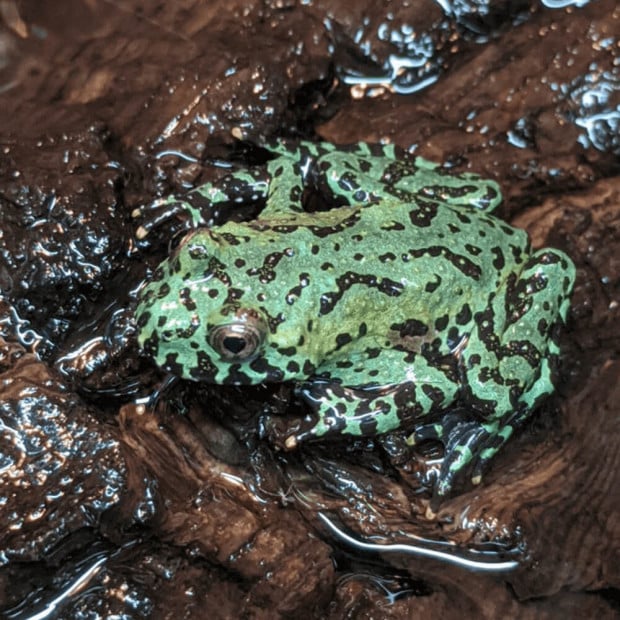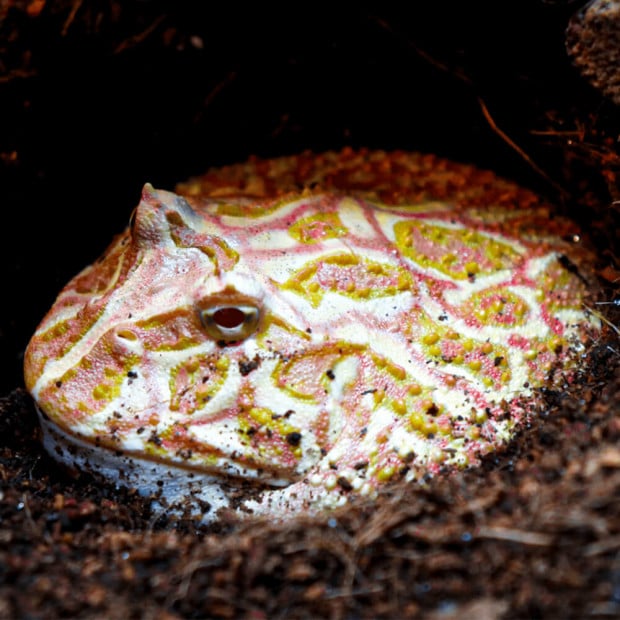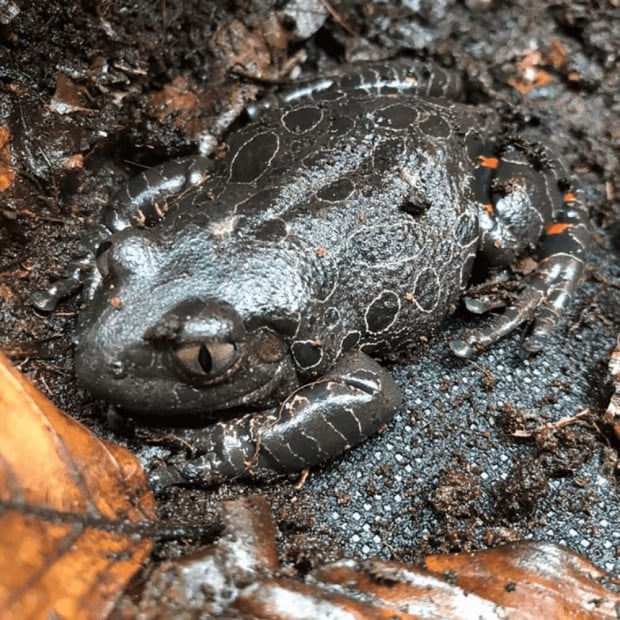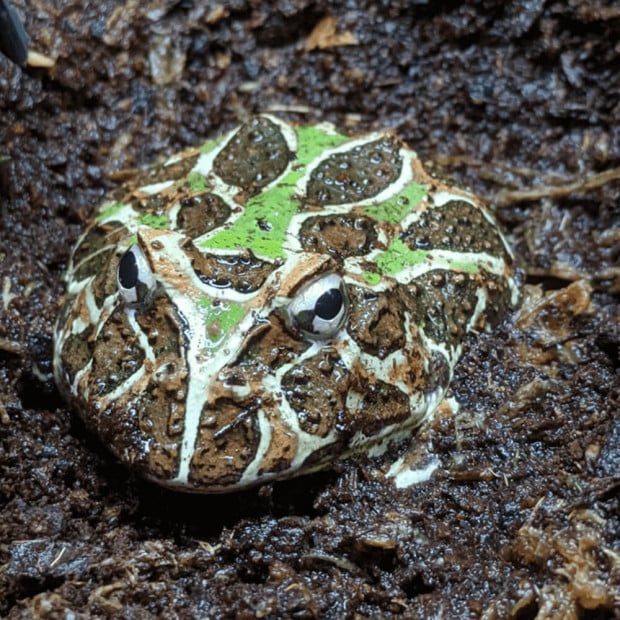- Fire salamanders are a great beginner amphibian
- Can be kept in pairs, although this should only be female-female
- Easy husbandry requirements and stunning markings
Do Fire salamanders make good pets?
Fire salamanders are a terrestrial species of amphibian that inhabits a wide range across Eastern, Southern and Central Europe. Fire salamanders are characterised by completely black bodies with yellow spots or stripes, and there are several subspecies within the species, some of which exhibit slightly different patterns.
Fire salamanders can be kept in pairs, but it is recommended only to keep females together, as males can become territorial and mixed-sex pairs are likely to breed, which in the long-term can lead to health issues in the female if she is overbred.
At Swell Reptiles, all of our Fire salamanders were captive bred in the UK, leaving you safe in the knowledge that your new pet came from a reputable source with minimal negative impacts on their native ecosystems.
Which enclosure should I choose for my Fire salamander?
Fire salamanders have fairly high humidity requirements, so glass or PVC enclosures tend to work the best, as wooden vivariums are likely to warp over time if moisture is allowed to seep into the joins of the vivarium. For a single adult or a pair of adult Fire salamanders, we recommend a minimum enclosure size of 90 x 45 x 45cm (36 x 18 x 18”), for example, the Exo Terra Glass Terrarium 90x45x45cm.
Do Fire salamanders need to be heated?
In most instances, Fire salamanders will not require an additional heat source. Hailing from the cool, damp forest floors of Europe, they do much better with a warm area sitting at around 24°C (75°F) and the cooler areas sitting closer to 20°C (68°F).
If a bit of help is required to reach these temperatures, a heat mat stuck to the side or back of the terrarium should be enough, but it is important that this is connected to an on/off thermostat to prevent the temperature from rising too high.
Do Fire salamanders need UVB?
Despite spending most of their time on the darker forest floors, Fire salamanders would still be exposed to sunlight in nature and can benefit significantly from a low-level UVB source, providing them with a UVI between 1-2.
This is usually achieved using an Arcadia ShadeDweller ProT5 Kit placed 25-40cm (10-15”) above the basking zone. If this distance will need to be greater, but no greater than 45cm (18”), an Arcadia ProT5 Kit - Forest 6% can be used.
What substrate should I use for my Fire salamander?
Due to their higher humidity requirements, a Fire salamander enclosure should incorporate a deep layer of loose, moisture-retaining substrate such as coco soil, or if you would prefer to use live plants, Arcadia EarthMix.
You may also wish to add a drainage layer of Hydro Rocks topped with Hydro Matting before adding the substrate, which will help prevent the soil from becoming waterlogged, protecting your plant roots whilst helping to increase the overall humidity.
How do I decorate a Fire salamander terrarium?
Your Fire salamander should first be provided with a few hiding areas to help them feel secure, either using traditional reptile caves, or pieces of natural reptile decor such as logs or cork bark pieces. You should also provide your Fire salamander with a good-sized water dish, large enough for the Salamander to soak in if they so choose.
Your Fire salamander habitat can then be further decorated using low branches, reptile moss and natural reptile decor, all of which will help to provide more cover for your Fire salamander, reducing stress whilst providing enrichment and enhancing the overall look of the enclosure.
What do Fire salamanders eat?
Fire salamanders are insectivores, and should be fed on a varied diet of livefoods including crickets, locusts, earthworms and calci worms. This alone is not enough for your Fire salamander's diet, to ensure it receives all of the nutrients they require to remain healthy, all livefood should be supplemented according to a feeding cycle.
At Swell Reptiles, we recommend using a calcium-rich multivitamin on every feed, such as Arcadia EarthPro-A, a calcium plus magnesium supplement on every fourth feed, such as Arcadia CalciumPro Mg and finally, a vitamin D3 supplement on every eighth feed such as Arcadia EarthPro RevitaliseD3 and finally, a vitamin a reptile supplement on every 12th feed, which is particularly important for most amphibians.
Can I Handle my Fire salamander?
All amphibians, including Fire salamanders, absorb water and other substances over a semi-permeable skin membrane. As human skin is often laced with salts, oils, lotions and so on, handling a Fire salamander can severely irritate their sensitive skin, so should be avoided wherever possible. If handling cannot be avoided, this should be done with clean, damp hands or gloves, and should be kept to an absolute minimum.
How do I buy a Fire salamander?
If you would like to purchase one of our UK captive bred Fire salamanders, you will need to collect this from our store, so please come in and see us. We will ask a few quick questions and also ask to see some images of your set-up, which should be completely ready for the animal to go into. We reserve the right to refuse adoption to anyone we feel is unprepared to adopt.
| Common names | Fire salamander, Yellow striped fire salamander, Galician fire salamander, Spotted fire salamander |
| Scientific name | Salamandra salamandra |
| Country | Europe |
| Captive-bred | Yes |
| Adult size | 17-25cm (7-10”) |
| Natural habitat | Forest floor habitats |
| Housing | 90 x 45 x 45cm (36 x 18 x 18”) |
| Ideal temperature | 24°C (75°F) (warm end); 20°C (68°F) (cool end) |
| UVI | 1-2 |
| Ideal humidity | 60-75% |
| Diet | Insectivorous |
| Average lifespan | 24-30 years |
| Personality | Reclusive |
| Ease of handling | Handling should be avoided |
| Cohabitable | Yes |
-
 Oriental fire-bellied toad, Bombina orientalisFrom £24.00Out of stock
Oriental fire-bellied toad, Bombina orientalisFrom £24.00Out of stock -
 Pacman frog, Ceratophrys cranwelliFrom £40.00 Regular Price £60.00 Save £20.00In stock
Pacman frog, Ceratophrys cranwelliFrom £40.00 Regular Price £60.00 Save £20.00In stock -
 Red leg running frogs, Phlyctimantis maculatusFrom £30.00In stock
Red leg running frogs, Phlyctimantis maculatusFrom £30.00In stock -
 Ornate pacman frog, Ceratophrys ornataFrom £75.00In stock
Ornate pacman frog, Ceratophrys ornataFrom £75.00In stock






